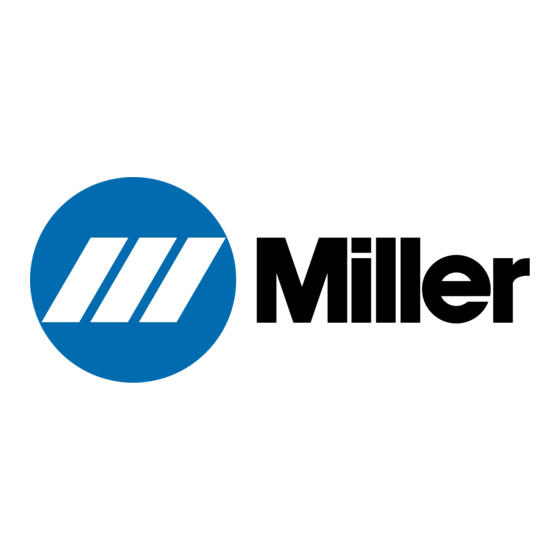Miller 900019 Installation And Operation Manual - Page 14
Browse online or download pdf Installation And Operation Manual for Welding System Miller 900019. Miller 900019 25 pages.

BAD
OVERLAP
OVERLAP
~NO
PENETRATION
Figure
9.1
WEAVING
When it is necessary
to
cover
a
wider
area
in
one
pass
of the
electrode,
a
method known
as
weaving
is
employed.
In
this
the
electrode
is
moved
or
oscillated from side
to
side in
a
set
pat
tern.
In order
to
be
sure
of uniform
deposits,
it
is
necessary
to
use
a
definite
pattern
such
as
FILLET
WELD
REI N
FORCEMENT
START~(cccc(c(c
DIRECFION OF WELDING
START~
~
D1R~TION
OF
WELDING
DIRECrr0N or
WELDIæ~~
Figure
10.1
those illustrated in
Figure
10.1. While
weaving
is
helpful, particularly
when
building
up
metal,
it
should be limited
to
weaves
not
exceeding
2‰
times
the diameter of the electrode.
BUTT JOINTS
Up
to
this
point
the discussion has covered
only
the
deposit
of beads
on
the fiat
plates.
While such
operations
are
helpful
in
building
up
worn
parts
or
applying hard-facing materials, they
do
not
help
in
learning
to
weld
pieces together.
For this
purpose,
other
types
of welds
as
illustrated
in
Figure
11.1
are
necessary.
In
making
bead
welds,
previously described,
it
was
probably
noted that the
depositing
of weld
metal
on one
side of the
plate
caused it
to
curl
up towards the
weld;
this is called distortion and
will almost
always
be found when heat is
applied
locally
to
a
metal
plate. Similarly
in
making
a
butt weld distortion will
cause
the
edges
of the
plate
to
draw
together
ahead of
welding.
This is
caused
by
the contraction of the
deposited
weld
metal
on
cooling.
It
may
be
overcome
by spread
ing
the
edges
apart
on a
long
taper
of about
V8
per
foot.
REINFORCEMENT
OF WELD
Figure
11.1
In
making
welds
in
a
butt
joint, preparation
of
the
edges
may be necessary
to
insure
good
results.
In metal
arc
welding
it is
common
practice
to
weld thin
materials up
to
3/16
thick without
any
special preparation
using
the
square groove
butt
joint.
For thickness of
3/16
and
over
the
V
groove either
single
or
double is
employed.
Generally
the
single
V
groove will be
satisfac
tory
on
thicknesses
up
to
3/4
and in those
cases,
regardless
of
thickness,
where
one
can
work
on
the
weld from
one
side
only.
The best
means
for
beveling
steel for
welding
is
by
means
of the
oxyacetylene cutting
torch.
The work
may be done
with
a
hand
guided
torch
or
special oxyacetylene
cutting
machine.
How
ever, in
performing
this
cutting,
a
scale will ad
here
to
the
plates.
This
must
be removed
by grind
ing
or
chipping
before
welding
as
it is
likely
to
become
entrapped
and thus
produce
an
unsound
weld. Where
oxyacetylene cutting equipment
is
not
available, grinding
will
probably
be the
best
means
of
preparing
bevels. The
angles
of these
bevels should be about 30
degrees
and the bottom
edge
may
be left
square
for
a
distance of about
1/16.
See
Figure
12.1.
-4
REINFORCEMENT
OF WELD
REINFORCEMENT
OF WELD
Double V
groove
weld
Single
V
groove weld
Square
groove
weld
BOTTOM OF PLATE
Figure
12.1
Page
12
